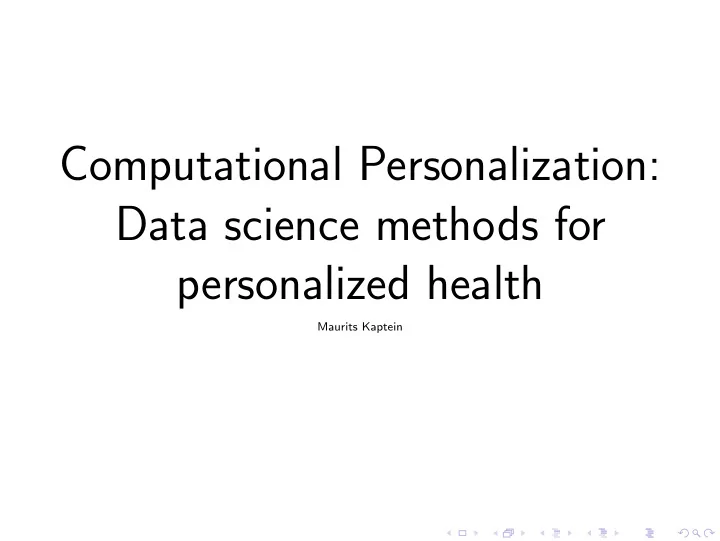

Computational Personalization: Data science methods for personalized health Maurits Kaptein
“Providing the right treatment to the right patient, at the right dose at the right time”
Outline: ◮ Defining personalized healthcare ◮ Analysis of the Randomized Controlled Trial (RCT) ◮ A computational approach to personalization
Defining personalized healthcare
{ patient , time , treatment , dose } f − → outcome .
f outcome ← − { patient , time , treatment , dose } f ← − { patient , time , treatment , dose } r f r ← − { x , a } = f ( x , a ; θ ) , r The reward, r , is a function of the context, x , (the characteristics of the patient), and the actions, a , (the treatment).
arg max f ( x , a ) a
T � arg max f ( x t , a t ) , a t t =1 We choose the treatments such that we maximize the reward over all treatments.
0.6 0.4 S u r v i v a l 0.2 1.0 0.0 0.8 20 0.6 Dose 40 0.4 Weight 0.2 60 0.0 80 0.6 0.6 0.5 0.5 0.6 0.4 0.4 0.4 S Survival Survival u r v Weight = 20 Weight = 60 i v a l 0.2 0.3 0.3 1.0 0.0 0.8 0.2 0.2 20 0.6 Dose 40 0.4 Weight 0.2 0.1 0.1 60 80 0.0 0.0 0.2 0.4 0.6 0.8 1.0 0.0 0.2 0.4 0.6 0.8 1.0 Dose Dose
Why is this difficult?
◮ High dimensional learning from noisy data
◮ High dimensional learning from noisy data ◮ Learning causal relationships
◮ High dimensional learning from noisy data ◮ Learning causal relationships ◮ Balancing learning and earning
The Randomized Controlled Trial
◮ Advantages: 1. Transparent and understandable 2. Causal effects through randomization 3. Practically appealing
◮ Advantages: 1. Transparent and understandable 2. Causal effects through randomization 3. Practically appealing ◮ Disadvantages: 1. Examines a very small number of options 2. Poor balancing of earning and learning 3. Inability to (re-)use data after trial
A computational approach
Disadvantages: 1. Loss of transparency: black-box
Disadvantages: 1. Loss of transparency: black-box 2. Practical challenges: no deterministic choices
Disadvantages: 1. Loss of transparency: black-box 2. Practical challenges: no deterministic choices 3. Causal effects not guaranteed: need additional analysis
Disadvantages: 1. Loss of transparency: black-box 2. Practical challenges: no deterministic choices 3. Causal effects not guaranteed: need additional analysis 4. Computationally challenging
Why would we want this?
Policy RCT Computational Personalization 30 Regret 20 10 0 0 200 400 600 800 1000 Interactions
800 600 Regret 400 200 Policy RCT (.754) Computational Personalization (1.0) 0 0 2000 4000 6000 8000 10000 Interactions
10 Policy RCT Computational Personalization 8 Estimator error 6 4 2 0 0 2000 4000 6000 8000 10000 Interactions
Conclusion
Recommend
More recommend